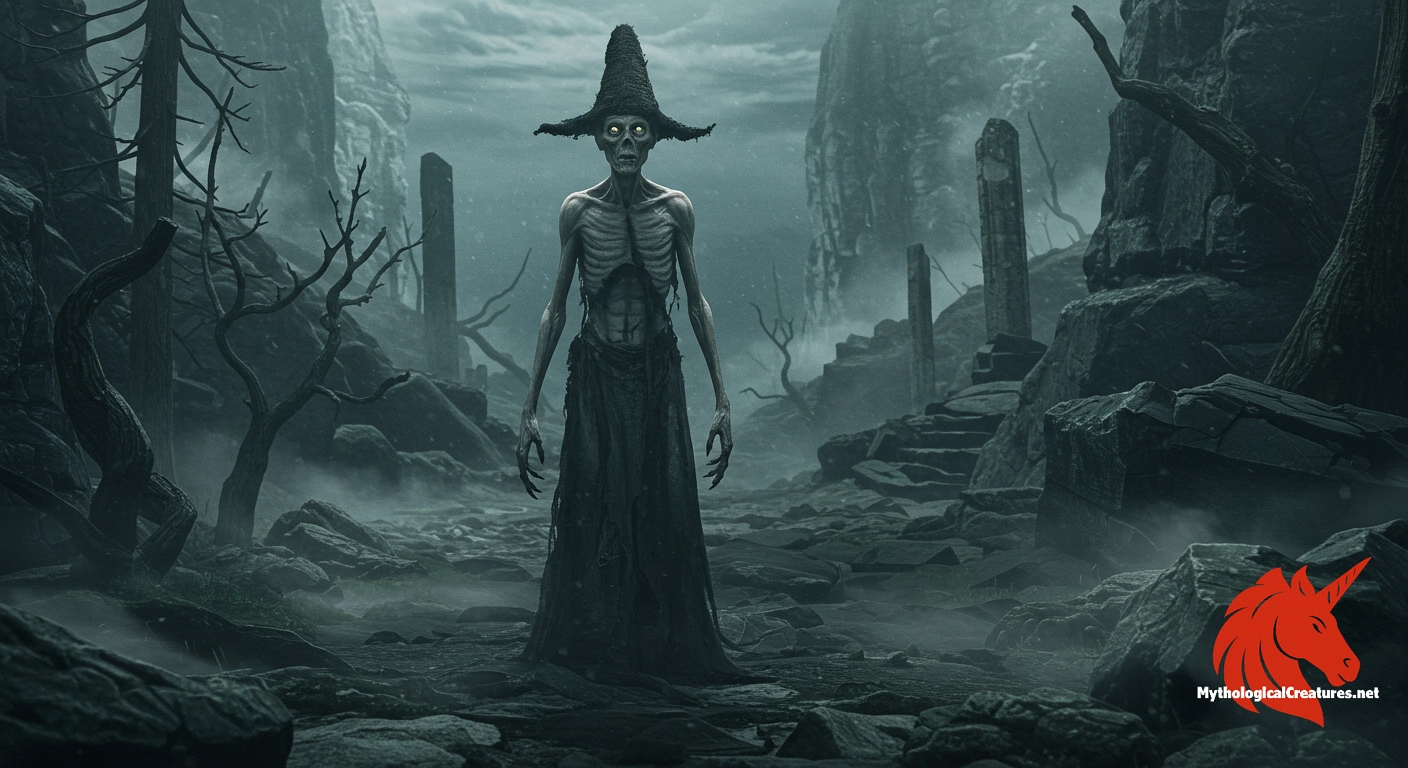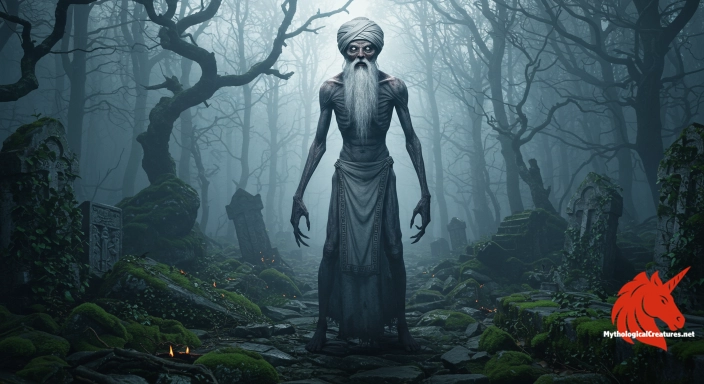Tuoni: Tuoni is the Finnish god of Tuonela, the underworld, and the personification of darkness.

Tuoni
Tuoni - Central figure in Finnish underworld myths, representing the inevitable nature of death and darkness.
Origins & First Encounters
Tuoni emerges in Finnish mythology as a compelling embodiment of the darkness that pervades the underworld of Tuonela, a realm where the limits between life and death blur. He is depicted as a timeless figure whose origins reside in ancient myth and oral tradition, shaped over centuries by the storytelling of Finnish peoples. His very existence is intertwined with the inevitable journey into the afterlife, infusing his myth with both mystery and solemnity. Traditional accounts recount that Tuoni is not merely a sovereign of shadows, but also a symbol of the deep, existential uncertainties that haunt the human spirit. His connection with the land of darkness is further underscored by his marriage to Tuonetar, which reinforces the balance of cosmic forces. The presence of his offspring, each linked to suffering and fate, enriches the narrative of inevitable loss and transformation that the underworld represents. Tuoni’s character, cast in the light of myth and legend, serves as a reminder of the inescapable ties between life, death, and the eternal cycle of nature. The cultural fabric of Finnish belief is embroidered with images of this deity, whose profound and somber role continues to spark contemplation and respect.
Source Texts & Tale Variants
The figure of Tuoni is woven into the fabric of Finnish myth through an array of ancient oral traditions and collective memories that have been passed from generation to generation. Narratives concerning his presence have been maintained in folklore, later finding a place in the burgeoning literary compilations that emerged during Finland’s national renaissance. While the Kalevala and other similar accounts offer subtle references to his dominion over the underworld, numerous local storytellers have contributed their own variations that enrich the character’s mystique. In many of these traditions, Tuoni is portrayed with consistent themes of inevitable darkness and the quiet, profound sorrow that accompanies death. The manifold story variants often differ in detail yet uniformly preserve the core essence of his authority over Tuonela and its shadowy landscape. Some versions highlight his interactions with human souls, painting a picture of a deity both enigmatic and implacable. The evolution of his legend from oral recitations to written texts has allowed newer generations to reinterpret his myth in layered and dynamic ways. As a result, multiple strands of narrative converge to create a complex portrait of a god who oversees the deepest mysteries of the human condition.
Form & Powers
Artistic depictions of Tuoni place a strong emphasis on his distinctive and otherworldly physical features, which set him apart from more conventional deities. In his human guise, he is consistently portrayed as an elderly figure, his age etching deep lines of wisdom and melancholy across his face. A particularly striking detail is his possession of only three fingers on each hand—a feature that symbolises his divergence from ordinary human physiology and hints at his supernatural nature. His attire often includes a hat formed from the essence of darkness itself, a visual element that reinforces his connection to the shadowy realms of death. The muted yet profound aura that seems to emanate from his appearance suggests that he is both an observer and a participant in the eternal cycle of life and decay. His physical form has been rendered in various artistic traditions with stark contrasts and somber colour palettes, each attempt further deepening his enigmatic presence. These unusual bodily characteristics invite both awe and introspection, encouraging viewers to question the boundaries between the mortal and the divine. The deliberate emphasis on his withered, spectral features underpins a broader symbolic narrative regarding the passage of time and the inevitability of fate.
Regional Faces
The myth of Tuoni adapts subtly to regional interpretations, reflecting local climate, culture, and historical context across Finland and neighbouring regions. In the colder, northern parts of Finland, portrayals of the underworld and its lord are imbued with an even more austere and barren character, mirroring the harsh environmental conditions. In contrast, southern traditions often present his image with a delicate interplay of poetic melancholy and enigmatic allure, as local lore tends to emphasise the lyrical qualities of his existence. Some communities describe him in tones that suggest a measure of compassionate inevitability, thereby softening the fear associated with the end of life. The character of Tuoni also finds echo in the mythologies of adjacent cultures, where he is sometimes merged with local spirits or deities that govern the realms of death. Notably, indigenous beliefs such as those of the Sami have occasionally incorporated elements of Tuoni’s persona into their own cosmological frameworks. This blending of myths across regions enriches the overarching narrative by allowing a variety of interpretations that speak to different human experiences of mortality. The inherent adaptability in his myth underscores how cultural context can shape the perception of even the most forbidding and immutable deities.
Cultural Parallels
Comparative mythology reveals that Tuoni shares many parallels with underworld deities in other cultural traditions, yet he retains a unique allure through his distinct attributes. In the realm of Greek mythology, Hades similarly presides over the underworld, yet Tuoni’s softer, more introspective portrayal emphasises the internal struggles associated with darkness. Roman mythology’s Pluto presents an equally compelling counterpart, though the emphasis in Tuoni’s iconography on peculiar details such as his three-fingered hands sets him apart. The mythic motif of a ruler in a shadowy domain is a recurring theme across cultures, and Tuoni’s narrative finds resonances in the Norse concept of Hel, despite differences in gender and artistic representation. The intergenerational transmission of his stories, like those of many death deities, reflects humanity’s universal fascination with mortality and the unknown. Distinct features such as his hat of darkness invite comparisons with other symbolic adornments attributed to psychopomps and guardians of the afterlife worldwide. The blend of fear, respect, and intrigue that Tuoni inspires is mirrored in the depiction of death in other mythological contexts, yet his uniquely personal traits continue to spark creative reinterpretation. Overall, the cross-cultural dialogue surrounding deities of the underworld enriches the understanding of Tuoni both as a specific Finnish icon and as a representative of broader mythological themes.
Legacy & Modern Evolution
Over the centuries, the depiction of Tuoni has evolved in tandem with shifts in cultural attitudes towards death and the afterlife. His early representations, steeped in the austere rituals of ancient oral tradition, emphasised a somber inevitability and an implacable mastery over the realm of darkness. As Finnish literature blossomed, Tuoni began to appear in written works and artistic endeavours that reimagined him as a complex, sometimes even compassionate, symbol of life’s ephemeral nature. Modern portrayals in literature, film, and visual arts have extended his legacy, often casting him in roles that explore the interplay between existential despair and a melancholic beauty. Contemporary interpretations recontextualise his myth within modern themes such as identity, transformation, and the passage of time. Artists and writers frequently draw on his enigmatic appearance—his aged visage, reduced digits, and dark hat—to evoke a sense of ancient wisdom and foreboding mystery. His enduring influence can be observed in how modern narratives of the underworld continue to draw on his archetypal presence, resonating with audiences attuned to both historical myth and the contemporary search for meaning. Festivals, reinterpretations in multimedia projects, and even elements in modern gaming ensure that Tuoni’s myth remains a living, dynamic part of cultural discourse, bridging the past with present-day reflections on mortality.
Interesting Fact
One of the most striking features of Tuoni is his three-fingered hands, a unique trait that not only distinguishes his human guise but also symbolises his profound connection to the shadowy realm of the underworld.
Quick Creature Info
Origin:
Associations:
Our Mythic Legendary Rating:

Habitat:
Supernatural Powers:
Physical Attributes:
Abilities:
Behavior:
Lore:
References
Discover Another Mythical Legend You May Not Have Heard Of?
Uncover the mysteries of ancient folklore and expand your knowledge of legendary beings from cultures around the world.
Dare to Meet the Peckols....
Mythical Disclaimer: The images and data on this site are derived from various historical and literary sources, but we have found that many myths often have multiple versions and interpretations across references, sometimes contradictory. As a result, these creature depictions are artistic interpretations—imaginative blends of folklore, legend, and a dash of AI guesswork. Because creature descriptions vary widely, our illustrations and accompanying information represent our best effort to honor mythology while bridging creative gaps. Enjoy these interpretations—just remember, we've done our best to respect the stories and validate available data, but in the realm of mythology, details often shift, imagination leads the way, and nothing is ever set in stone!
Curated by the Mythological Creatures Team (rev. May 2025)
